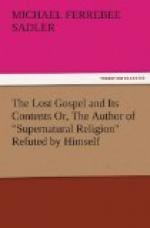The writers, whose testimonies to the existence or use of our present Gospels are examined by the author, are twenty-three in number. Five of these, namely, Hegesippus, Papias, Melito, Claudius Apollinaris, and Dionysius of Corinth are only known to us through fragments preserved as quotations in Eusebius and others. Six others—Basilides, Valentinus, Marcion, Ptolemaeus, Heracleon, and Celsus—are heretical or infidel writers whom we only know through notices or scraps of their works in the writings of the Christian Fathers who refuted them. The Epistle of the Martyrs of Vienne and Lyons is only in part preserved in the pages of Eusebius. The Canon of Muratori is a mutilated fragment of uncertain date. Athenagoras and Tatian are only known through Apologies written for the Heathen, the last of all Christian books in which to look for definite references to canonical writings. The Epistle to Diognetus is a small tract of uncertain date and authorship. The Clementine Homilies is an apocryphal work of very little value in the present discussion.
These are all the writings placed by the author as subsequent to Justin Martyr. The writers previous to Justin, of whom the author of “Supernatural Religion” makes use, are Clement of Rome (to whom we shall afterwards refer), the Epistle of Barnabas, the Pastor of Hermas, the Epistles of Ignatius, and that of Polycarp.
As I desire to take the author on his own ground whenever it is possible to do so, I shall, for argument’s sake, take the author’s account of the age and authority of these documents. I shall consequently assume with him that
“None of the epistles [of Ignatius] have any value as evidence for an earlier period than the end of the second or beginning of the third century [from about 190 to 210 or so], if indeed they possess any value at all.” [6:1] (Vol. i. p. 274.)
With respect to the short Epistle of Polycarp, I shall be patient of his assumption that
“Instead of proving
the existence of the epistles of Ignatius, with
which it is intimately associated,
it is itself discredited in
proportion as they are shown
to be inauthentic.” (Vol. i. p. 274)
and so he
“assigns it to the latter
half of the second century, in so far as
any genuine part of it is
concerned.” (P. 275)
Similarly, I shall assume that the Pastor of Hermas “may have been written about the middle of the second century” (p. 256), and, with respect to the Epistle of Barnabas, I shall take the latest date mentioned by the author of “Supernatural Religion,” where he writes respecting the epistle—




